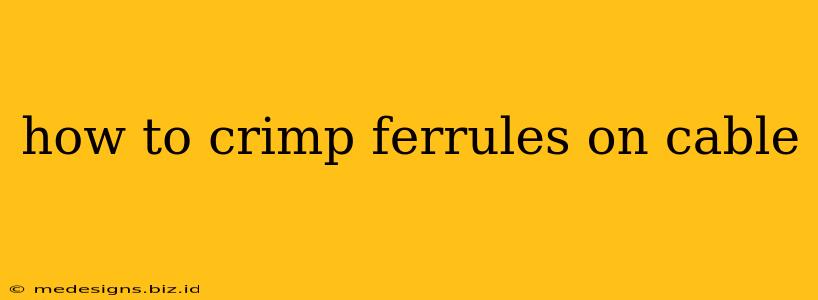Crimping ferrules onto cables is a crucial step in many electrical and electronic applications. Properly crimped ferrules ensure a secure, reliable connection, preventing wire breakage and ensuring optimal signal transmission. This guide will walk you through the process, covering the necessary tools and techniques for a professional finish.
Understanding Ferrules and Their Importance
Ferrules are small, metal sleeves that are crimped onto the ends of wires. They serve several vital purposes:
- Strain Relief: Ferrules prevent the wires from fraying or breaking at the point of connection, offering excellent strain relief. This is especially important in applications where the cable experiences movement or vibration.
- Improved Conductivity: The ferrule's conductive material provides a larger surface area for connection, improving conductivity and reducing resistance. This leads to better signal transmission and prevents heat buildup.
- Enhanced Durability: The crimped ferrule protects the wire from corrosion and damage, extending the lifespan of the connection.
- Professional Finish: Using ferrules gives a clean, professional look to any wiring project.
Tools You'll Need for Crimping Ferrules
Before you begin, gather the following essential tools:
- Wire Strippers/Cutters: Choose a pair that can cleanly strip the insulation from your wire without damaging the conductors.
- Crimping Tool: This is the most crucial tool. A good quality crimping tool designed specifically for the size and type of ferrules you're using is essential for a secure crimp. Avoid using pliers or other makeshift tools, as this can damage the ferrule and the wire.
- Ferrules: Select ferrules that match the size and type of your wire. Ensure you have enough for the job.
- Wire: The cable you'll be working with.
Step-by-Step Guide to Crimping Ferrules
Let's proceed with the crimping process:
1. Prepare the Wire:
- Measure and Cut: Carefully measure and cut the wire to the desired length. Leave a little extra length for flexibility.
- Strip the Insulation: Use your wire strippers to carefully strip back the insulation from the end of the wire. Avoid nicking the wire strands. The length of the stripped portion should be slightly longer than the ferrule's length.
2. Insert the Wire into the Ferrule:
- Alignment is Key: Ensure the stripped wire is straight and neatly inserted into the ferrule, all the way to the bottom. A slightly snug fit is ideal.
3. Crimp the Ferrule:
- Proper Tool Use: Place the ferrule and wire into the jaws of your crimping tool. Make sure the ferrule is properly seated in the jaws.
- Apply Even Pressure: Squeeze the crimping tool handles firmly and evenly until the tool clicks or offers resistance indicating a complete crimp. Avoid using excessive force. A properly crimped ferrule will have a solid, uniform crimp around the entire circumference of the ferrule.
4. Inspect the Crimp:
- Check for Imperfections: After crimping, carefully examine the ferrule. The crimp should be tight and secure. Any loose or uneven crimps indicate improper crimping and the connection should be remade. A poorly crimped ferrule can lead to connection failures.
Choosing the Right Ferrules
Selecting the appropriate ferrules is vital for a successful crimp. Consider these factors:
- Wire Gauge: Ferrules are sized to match specific wire gauges. Use the wrong size, and you risk a poor connection.
- Material: Ferrules are typically made of copper or tinned copper. Choose a material suitable for your application.
- Insulation Type: Ensure the ferrule is compatible with the insulation type of your wire.
Troubleshooting Common Problems
- Loose Crimp: This usually indicates insufficient pressure applied during crimping. Use a proper crimping tool and apply firm, even pressure.
- Damaged Wire: Avoid nicking the wire when stripping insulation. This can weaken the wire and compromise the connection.
- Uneven Crimp: This could be due to misalignment in the crimping tool. Ensure the ferrule is properly seated in the tool's jaws.
By following these steps and using the correct tools, you can confidently crimp ferrules onto cables, ensuring reliable and durable connections for your projects. Remember, practice makes perfect! Take your time, and don't hesitate to start with some scrap wire to refine your technique.
